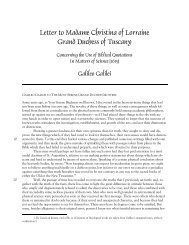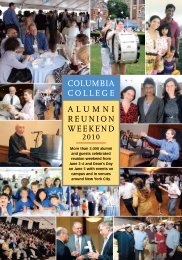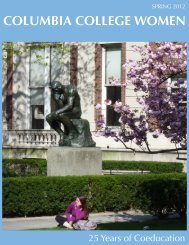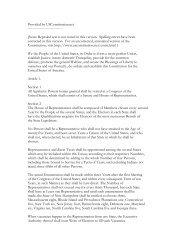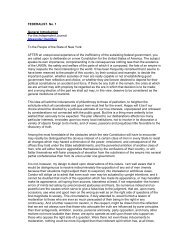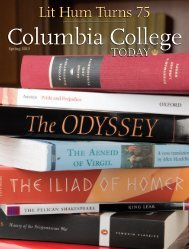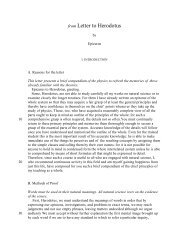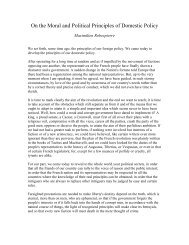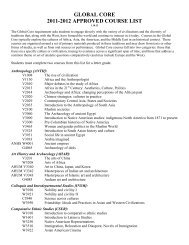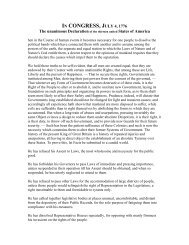Japan Storm - Columbia College - Columbia University
Japan Storm - Columbia College - Columbia University
Japan Storm - Columbia College - Columbia University
You also want an ePaper? Increase the reach of your titles
YUMPU automatically turns print PDFs into web optimized ePapers that Google loves.
COLUMBIA COLLEGE TODAY JAPAN AFTER THE STORM<br />
The tsunami, measured at one location at 128 feet, washes away cars as it approaches Miyako City.<br />
PHOTO: HITOSHI KATANODA/POLARIS<br />
devastation. It is going to take imagination, money, bold planning<br />
and strong political leadership to rebuild this area. The rice<br />
fields have been inundated with salt water and the land in many<br />
places has sunk 70–80 centimeters. Restoring this land to agricultural<br />
use will be difficult and expensive. The port will be restored<br />
and airport repairs will be completed, but in the absence of some<br />
development scheme, the population of this corner of Sendai and<br />
even more so in the affected towns along the coast undoubtedly<br />
will decline, leaving behind mostly elderly people who cannot or<br />
do not want to leave the only place they have ever known, even<br />
if there is nothing there.<br />
The tsunami had rolled across the Sendai airport, washing<br />
mud and debris onto the runways and doing extensive damage<br />
to the terminal building. With the bullet train system down, the<br />
airport not functioning, boats unable to enter the Sendai port and<br />
roadways cracked and covered with debris, it was a monumental<br />
task to get relief supplies and rescue workers into the region.<br />
In the days immediately following the earthquake, the U.S.<br />
military in <strong>Japan</strong> launched Operation Tomodachi (tomodachi<br />
meaning friend), ferrying supplies by helicopter from the aircraft<br />
carrier U.S.S. Ronald Reagan, which had changed course to<br />
go to <strong>Japan</strong>ese waters to assist the<br />
humanitarian effort. A team of Air<br />
Force special forces flew from Okinawa<br />
to a <strong>Japan</strong>ese SDF airbase near<br />
Sendai and then traveled to the airport<br />
in Humvees they had brought<br />
with them. Within a few hours the<br />
team had enough of one of the runways<br />
cleared for C-130s to land with<br />
emergency supplies. When I got to<br />
the airport 1½ months later, the run-<br />
ways were open for limited domestic<br />
civilian traffic but the passenger<br />
terminal building had been so badly<br />
Professor Gerald Curtis visits the disaster zone as part of a<br />
documentary for <strong>Japan</strong>ese television.<br />
PHOTO: COURTESY GERALD CURTIS<br />
WINTER 2011–12<br />
23<br />
damaged that there was only one small area being used for ticketing<br />
and passenger check-in.<br />
The <strong>Japan</strong>ese press and television coverage of the activities of<br />
the American troops no doubt reinforced <strong>Japan</strong>ese public support<br />
for alliance with the United States. U.S. military personnel, in addition<br />
to their work in opening the airport and ferrying in supplies,<br />
worked with the SDF in the offshore search for victims. They also<br />
cleared the debris at one of the many damaged train stations.<br />
American participation in efforts to help people in Tohoku has<br />
not been limited to the military. There are American and other<br />
foreign volunteers working with <strong>Japan</strong>ese and international<br />
NGOs throughout the disaster zone. One of these is an international<br />
disaster relief organization, All Hands, which is active in<br />
Ofunato city in Iwate prefecture. What the American volunteers<br />
working with All Hands are doing is a reminder that the U.S.-<br />
<strong>Japan</strong> relationship is far more than a military alliance.<br />
The great majority of Americans working in Tohoku with All<br />
Hands and with other NGOs are people living in <strong>Japan</strong>. A typical<br />
case is that of a businessman who has been in Kanazawa for more<br />
than 15 years, who took time off from work to volunteer with All<br />
Hands, saying that after all <strong>Japan</strong> has done for him he could not<br />
stay away and do nothing.<br />
Another American there turned<br />
out to be a student of mine from 20<br />
years ago. (Teach long enough and<br />
former students show up in all sorts<br />
of unexpected places.) Having gone<br />
from <strong>Columbia</strong> to a successful career<br />
as an investment banker, he became<br />
prosperous and was enjoying retired<br />
life in Tokyo until the earthquake<br />
struck. Able to set his schedule as<br />
he likes, he decided to do volunteer<br />
work with All Hands, and this subsequently<br />
became his calling. He heads




